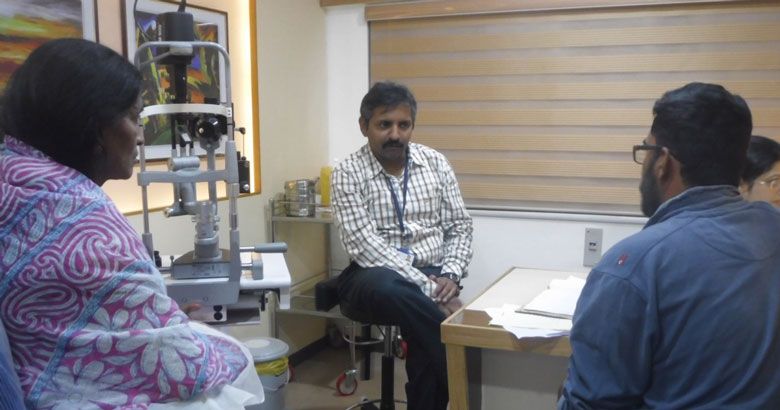“Revathy’s last days were spent not only in despair but also in darkness,” said Devi, the caregiver for 3 young children Revathy, a young, 34 year-old widow with AIDS who died from CMV retinitis, left behind.
In India, opportunistic infections—including eye infections like CMV retinitis—are a major cause of morbidity and mortality in immune-compromised HIV-positive patients. And until antiretroviral therapy (ART) becomes freely accessible to all patients, the incidence of these infections will continue to climb.
The majority of people living with HIV/AIDS will experience at least one ocular complication—the most dreaded being potentially blinding cytomegalovirus retinitis (CMV) retinitis, caused by a pathogen that is able to infiltrate the eye. CMV retinitis comes from the same family of infections that are responsible for producing a common cold sore.
CMV retinitis is both preventable and curable with medicines such as ART—but the high cost of ART is prohibitive for many patients. And according to a team of researchers led by the WHO, the prevalence in Asia does not appear to have changed over the past decade, with 14% of HIV patients contracting CMV retinitis and 1/3 of these patients suffering vision loss in one or both eyes. People unaware of their HIV-positive status, those who do not adhere to their treatment regimen, and patients who are resistant to first-line ART are especially susceptible.
Limited ART access is one of the major factors placing HIV-positive individuals at risk to develop CMV. According to the UNAIDS 2015 Gap Report, India has the third highest incidence of HIV cases in the world (after South Africa and Nigeria), but only 30% of its eligible HIV-positive population receives ART.
Prathap, a 41-year-old HIV-positive daily wage laborer in Madurai on ART therapy for the last 7 years, reported, “The situation is getting worse. At times, I am given only a week’s supply and have to come back to the clinic when they call to get the rest of the supply. This means I have to take an extra day off work. It is a loss of income for me but I have to stay alive for my children, so I try my best not to miss the pills.”
When asked why he did not see a private doctor, Prathap responded, “I don’t have the luxury. The treatment at the government center is free and I make only 400 rupees a day.”
Today, close to ¼ of India’s population lives on a daily income lower than the price of a cup of Starbucks coffee. Live Prathap, many HIV-positive people cannot afford to risk their jobs to visit the free government clinics. And when patients miss doses, the virus continues to spread, and drug resistance and reliance on second-line ART therapy grows. Although the National AIDS Control Organization (NACO) website states that second-line therapy is provided for free, this decision is made on a case-by-case basis. N. Kumarswamy, MD, chief medical officer of YRG Care at the Voluntary Health Services Hospital in Chennai, says that it has taken months for some patients to procure second-line treatment, upping the incidence of opportunistic infections such as CMV.
At a metropolitan government hospital, the head of operations (who asked that his name not be used) voiced similar frustrations after waiting 2 weeks to obtain the medication, known as Valganciclovir, to treat CMV: “We are provided with protocols on how to treat opportunistic infections. We see patients coming with CMV, yet we have no resources. The central government does not provide us with the medication to treat CMV, like they do with ART.” He ordered the medicine from another government center that could only offer a partial course for 1 patient. “I have several patients with CMV: Whose sight should I save?” he asked.
Paradoxically, while India struggles with drug shortages, it is also one of the developing world’s major pharmaceutical hubs, because of its ability to produce affordable generic medications, including ART. According to a recent report by Doctors Without Borders, “More than 80% of HIV medicines used to treat 6.6 million patients in developing countries come from Indian producers.” In 2001, Cipla cut costs by 97%, making it possible to deploy ART medication free of cost to HIV-positive people living in India. Yet, the medicine has only flowed to 1/3 of eligible people..
Another Indian pharmaceutical company, Rambaxi, produces a generic version of Valganciclovir, yet the price still remains largely out of reach. If India has the capacity to produce medications, why are there acute shortages at government-run antiretroviral therapy centers?
The government’s disorganization and inability to distribute funds appropriately comprise the quality of prevention programs, leading to a nationwide scarcity.
NACO has rolled out 4 different phases to deal with the HIV epidemic, with original funding from international agencies such as the World Bank. NACO’s early plans envisioned that the role of donors would gradually decrease and the Indian government would manage the program on its own, but the transition has proved rocky since the start of Phase IV in 2012. In 2012, one of the biggest donors, the Global Fund to Fight AIDS, Tuberculosis and Malaria (GFATM), which had pledged $187 million, pulled out after the government failed to provide sufficient details about its spending.
A lack of external donors has fueled a silent shift towards apathy and indifference. Most recently, Prime Minister Modi cut the 2015-16 central AIDS budget by 22% and asked state governments to fill the gap, resulting in drug shortages and havoc at numerous ART centers.
